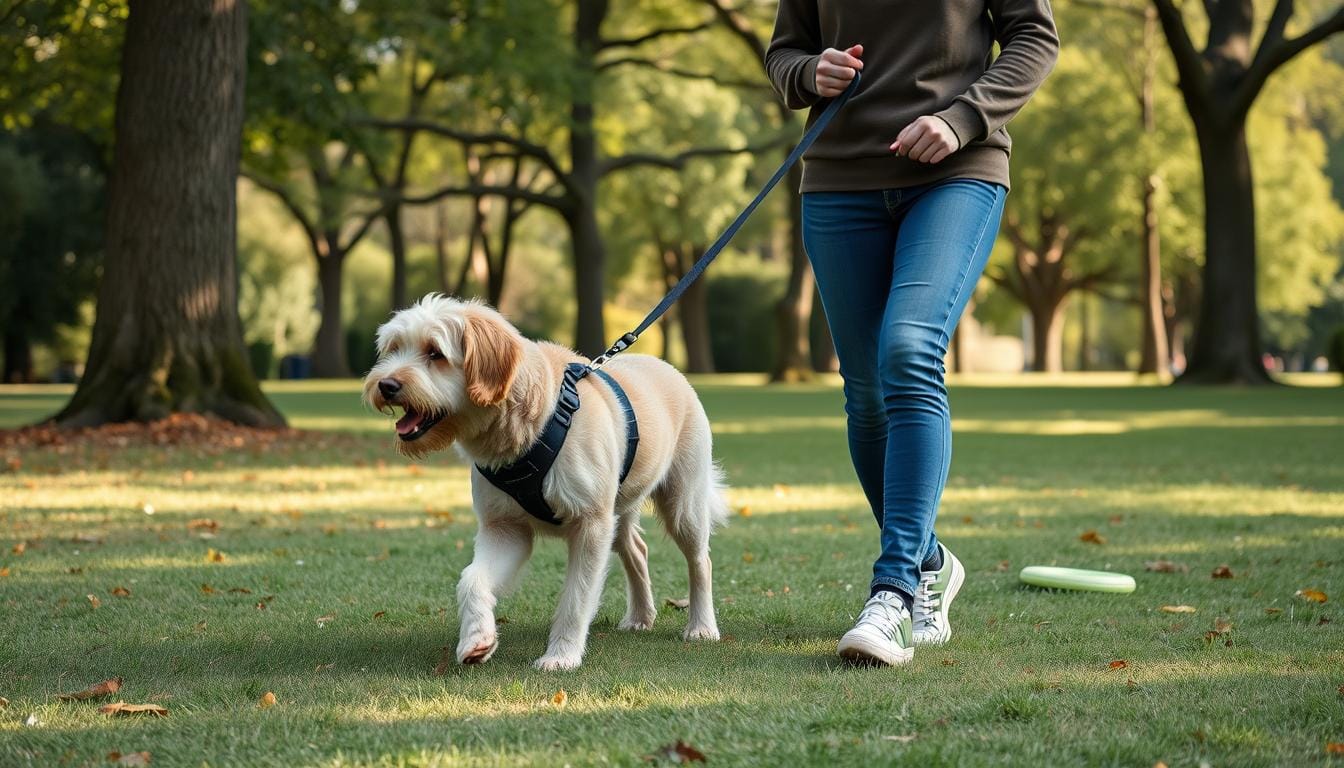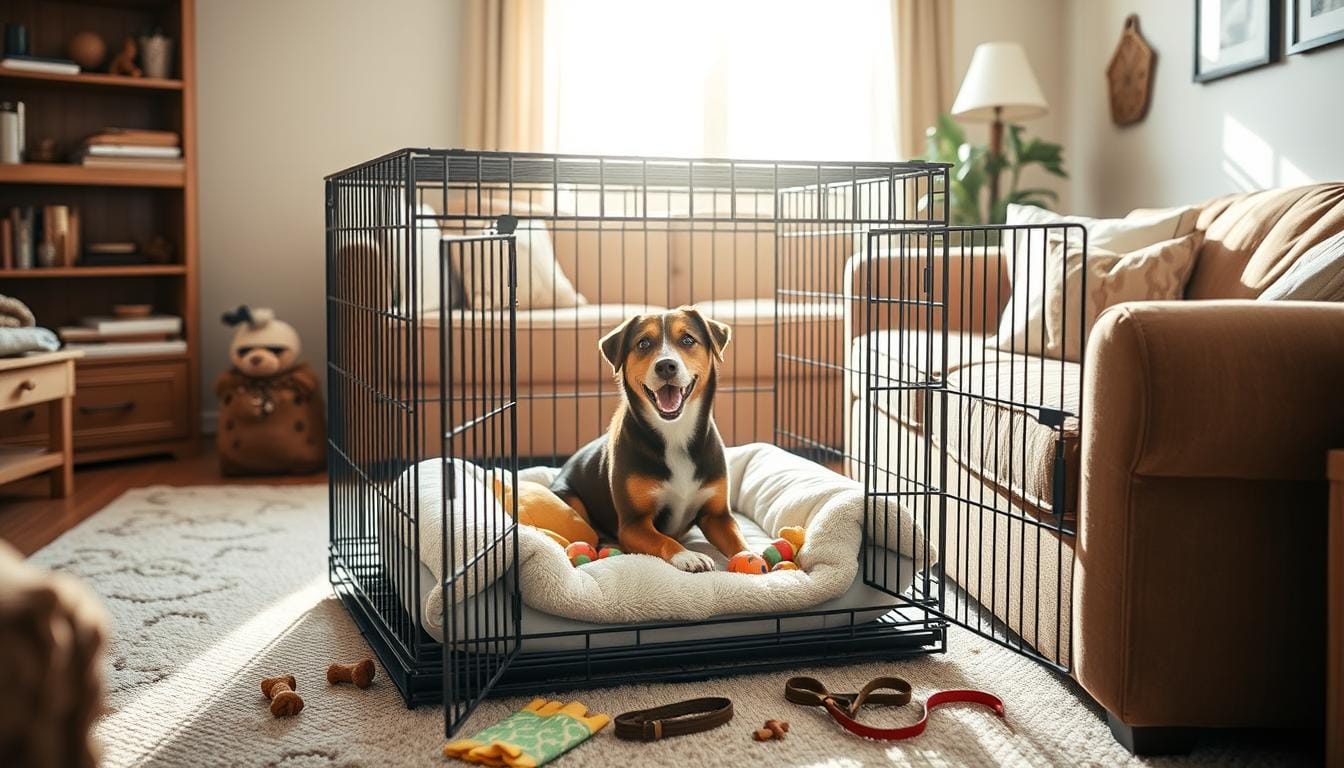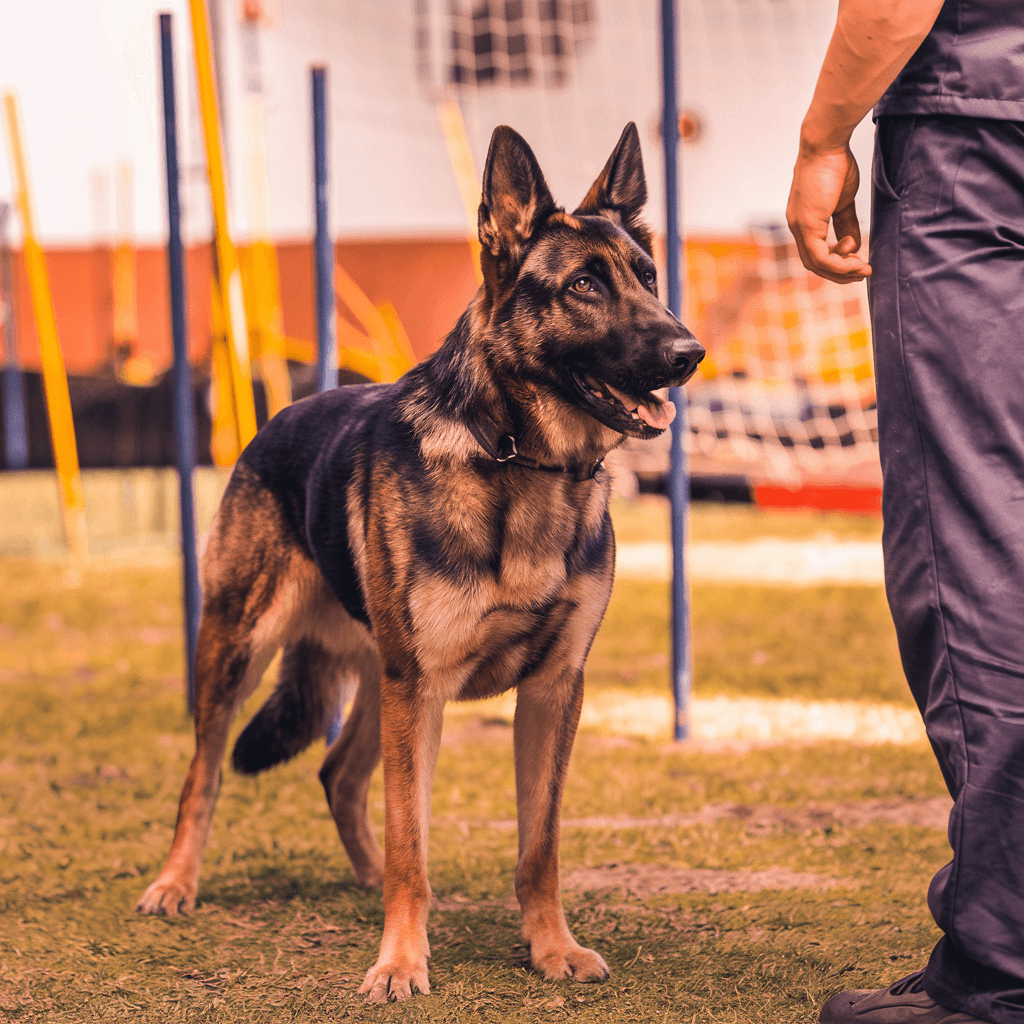Did you know dogs can sense human emotions instinctively? It’s true! These amazing creatures use subtle cues to communicate with us, showcasing their emotional intelligence. But while our furry friends excel at reading our feelings, they often struggle to express their own discomfort, especially when it comes to dental issues.
We invite you to explore the deep bond between humans and dogs by learning about an often-overlooked aspect of pet health: dog dental care. Regular dog teeth cleaning plays a crucial role in maintaining your canine companion’s overall well-being and oral hygiene.
Proper dental care for dogs goes beyond fresh breath and pearly whites. It’s a vital component of pet health that impacts your dog’s quality of life. By understanding the importance of regular teeth cleaning, we can ensure our loyal companions stay happy and healthy for years to come.
Key Takeaways
- Regular teeth cleaning reduces the risk of cavities and tooth decay in dogs
- Good dental health decreases the likelihood of infections and abscesses
- Professional teeth cleaning can lower the chances of heart disease in dogs
- Over 80% of dogs older than three develop periodontal disease
- Smaller breeds and dogs with short faces are more prone to dental issues
- Home dental care products can help maintain oral hygiene between professional cleanings
Understanding Canine Dental Health
Keeping our furry friends’ teeth clean is key to their health. Sadly, many dog owners overlook this, with two-thirds not caring for their pet’s teeth. This can lead to serious dental problems and harm their quality of life.
Common dental problems in dogs
Dogs often face dental issues, with periodontal disease being the most common. The American Veterinary Medical Association says 80% of dogs get dental disease by age two. This shows how important it is to take care of their teeth early on.
The link between oral health and overall well-being
Good oral health is linked to a dog’s overall health. Bad teeth can lead to heart disease and organ failure. But, dogs with clean teeth are less likely to get these diseases. Regular brushing can greatly reduce dental disease and related health issues.
Signs of dental issues in dogs
It’s crucial to spot dental problems early. Look out for:
- Bad breath
- Difficulty eating
- Visible tartar buildup
- Swollen or bleeding gums
- Changes in behavior or appetite
Plaque can form on a dog’s teeth in just six hours after cleaning. This shows why regular dental care is so important.
| Age Group | Dental Concerns | Recommended Care |
|---|---|---|
| Young Dogs (1-2 years) | Plaque buildup, early signs of gum disease | Annual exams, start home care routine |
| Adult Dogs (3-7 years) | Periodontal disease, tartar accumulation | Regular professional cleanings, daily brushing |
| Senior Dogs (8+ years) | Damaged teeth, gum inflammation | More frequent check-ups, specialized dental diets |
Why Regular Dog Teeth Cleaning Matters
Keeping your dog’s teeth clean is key to their health. Dental care is vital for their overall well-being. Neglecting it can cause serious problems. Let’s see why regular dental care is so important for dogs.

Many dogs suffer from periodontal disease. This can cause pain, tooth loss, and harm vital organs if not treated. Regular teeth cleaning helps prevent plaque and tartar buildup, which cause dental issues.
Professional teeth cleaning involves scaling to remove plaque and tartar. These cleanings are done under general anesthesia for your pet’s safety. While important, daily brushing at home with dog toothpaste also helps a lot.
| Dental Care Practice | Frequency | Benefits |
|---|---|---|
| Professional Cleaning | 1-2 times per year | Thorough removal of plaque and tartar |
| At-home Brushing | Daily | Prevents plaque buildup, freshens breath |
| Dental Chews | 5-10 minutes daily | Helps clean teeth and gums |
By focusing on dental health, we can prevent painful dental issues. This keeps their breath fresh and saves on vet bills. A healthy mouth means a happy, healthy dog!
The Benefits of Professional Dog Teeth Cleaning
Professional dental cleaning is key to your dog’s health. Regular cleanings boost your pet’s oral hygiene and overall well-being. Let’s look at the main benefits of professional dog teeth cleaning.
Preventing Tooth Loss
Professional dental cleaning helps prevent tooth loss. Many dogs show signs of periodontal disease by age three. Cleanings remove plaque and tartar, reducing gum disease risk and saving your dog’s teeth.
Eliminating Bad Breath
Bad breath in dogs often means dental problems. Professional cleaning removes bacteria and food particles causing bad smells. This professional dental cleaning not only freshens breath but also boosts dog hygiene.
Reducing the Risk of Organ Damage
Poor dental health can harm your dog’s body. Bacteria from dental infections can reach vital organs like the heart, liver, and kidneys. Regular cleanings keep your dog healthy by preventing these serious issues.
Here’s a breakdown of the benefits of professional dog teeth cleaning:
| Benefit | Impact on Dog Health |
|---|---|
| Plaque Removal | Reduces risk of periodontal disease |
| Gum Health | Prevents gingivitis and receding gums |
| Detect Dental Issues | Early identification of tooth fractures or cavities |
| Improved Overall Health | Reduces risk of heart, kidney, and liver problems |
By focusing on professional dental cleanings, you’re investing in your dog’s health and happiness. Good oral care is crucial for responsible pet ownership.
The Process of Professional Dog Teeth Cleaning
Professional dog teeth cleaning is a key part of veterinary dentistry. It involves several steps to keep your dog’s teeth and gums healthy.
The first step is a detailed oral exam. Veterinarians check your dog’s teeth and gums for any problems. They look for signs of periodontal disease, which often starts by age three.
Then, bloodwork is done to check if your dog is healthy enough for anesthesia. This is important to make sure the anesthesia is safe.

Under anesthesia, full mouth radiographs are taken. These x-rays show hidden problems, as half of each tooth is hidden under the gum line. The cleaning starts with scaling to remove plaque and tartar, followed by polishing.
In some cases, teeth may need to be pulled. After that, radiographs are taken again to make sure the tooth is fully removed. Your vet will also give you instructions on how to care for your dog at home, like feeding soft food for two weeks if teeth were pulled.
| Age Group | Dental Care Needs | Risk Factors |
|---|---|---|
| Young Dogs (under 3) | Regular check-ups | Toy breeds may need cleanings as young as 2 years |
| Adult Dogs (3-6 years) | Annual dental cleanings | 80% have periodontal disease |
| Senior Dogs (7+ years) | More frequent cleanings | Higher risk of dental issues |
Regular dental care and exams are crucial for your dog’s health. Small dogs and breeds with short noses need more frequent cleanings. Dogs that chew a lot may need extra care to avoid tooth damage.
Dog Teeth Cleaning: Anesthesia and Safety Concerns
Many pet owners worry about anesthesia for dogs during dental cleanings. We’ll look into why it’s needed and how vets keep dental care safe.
Why Anesthesia is Necessary
Anesthesia lets for a deep clean, reaching 60% of the tooth below the gumline. It also allows for dental X-rays, key for spotting hidden problems like infections or bone loss. Without it, these issues might not be found.
Safety Measures and Precautions
Vets take many steps to keep your dog safe during anesthesia. These include:
- Placing an intravenous catheter
- Monitoring vital signs with advanced equipment
- Maintaining blood pressure with fluids
While serious problems are rare, some dogs face extra risks. These include brachycephalic breeds and dogs with health issues. Your vet will talk about any special worries based on your dog’s health and breed.
Pre-cleaning Health Checks
Before starting, we do detailed health checks. These include:
- Pre-anesthetic blood work to check organ function
- Evaluating hydration and glucose levels
- Looking for anemia or infections
These checks help decide if it’s safe to do the cleaning. Remember, cheaper anesthesia-free cleanings can’t fix serious dental problems. They can’t give your dog the full care they need for good oral health.
At-Home Dog Dental Care Techniques
Good dog dental care starts at home. We can help our furry friends keep their teeth and gums healthy with simple at-home techniques. Let’s look at some effective ways to keep your dog’s mouth clean and fresh.
Brushing your dog’s teeth
Brushing is the best way to keep your dog’s teeth clean. Food-motivated dogs who can sit still for a few minutes usually do well with tooth brushing. Try to brush 2-3 times a week, or every day if you can. Use a dog-specific toothbrush and toothpaste for the best results.
Dental treats and chews
Dental treats can be a tasty way to support your dog’s oral health. Look for products with the Veterinary Oral Health Council’s Seal of Acceptance. These treats help control tartar buildup and freshen breath. Add them to your dog’s regular dental care routine.
Dental-specific diets
Special diets can help keep your dog’s dental health in check. Prescription dental foods, like Purina® ProPlan® Veterinary Diets DH Dental Health, are clinically proven to reduce dental disease. For extra benefit, try adding VetriScience® Perio Support dental powder to each meal.
| At-Home Technique | Frequency | Benefits |
|---|---|---|
| Tooth brushing | 2-3 times per week (daily ideal) | Removes plaque, prevents tartar buildup |
| Dental treats | Daily | Controls tartar, freshens breath |
| Dental-specific diet | Every meal | Reduces dental disease risk |
By adding these at-home techniques to your dog’s routine, you can greatly improve their dental hygiene and overall health. Remember, professional cleanings are still needed, but consistent home care can make them less frequent.
The Role of Diet in Canine Dental Health
A well-balanced dog diet is key for good dental health. It helps keep teeth and gums strong, lowering the chance of gum disease. Certain foods can greatly affect your dog’s mouth health.
Dry kibble can help remove plaque as dogs chew. But, the quality of the food is important. Low-quality dry food might even cause more tartar buildup. On the other hand, wet food provides important nutrients for health.
Adding specific ingredients to your dog’s diet can improve dental health:
- Miscanthus grass: Helps clean teeth by scraping away plaque
- Sweet potatoes: Rich in vitamins supporting gum and tooth structure
- Coconut: Contains lauric acid with antimicrobial properties
- Pumpkin: Aids digestive health, indirectly benefiting oral wellness
- Green tea extract: Reduces gum inflammation and fights bad breath
Probiotics in yogurt help keep the mouth’s bacteria in balance. Blueberries, full of antioxidants, stop plaque-causing bacteria from sticking to teeth and gums.
| Ingredient | Benefit |
|---|---|
| Alfalfa leaves | Strengthen teeth and bones |
| Inulin | Supports healthy gut and oral microbiome |
| Green tea extract | Combats dental diseases |
Remember, a balanced diet helps your dog absorb nutrients better. This keeps their gut healthy, which supports their dental health. Talk to your vet to make a diet plan that meets your dog’s dental needs.
Recognizing and Treating Periodontal Disease in Dogs
Periodontal disease is a big problem for many dogs. It affects 80-90% of dogs over 3 years old. We’ll look at the stages, treatments, and the bad effects of this common issue.
Stages of Periodontal Disease
Periodontal disease goes through four stages:
- Gingivitis: Mild gum inflammation
- Early periodontitis: Slight bone loss
- Moderate periodontitis: Significant bone loss
- Advanced periodontitis: Severe bone loss and tooth mobility
Treatment Options
Dog dental treatment depends on the disease stage. A professional cleaning under anesthesia is key to remove plaque and tartar. For severe cases, tooth extraction or surgery might be needed. Brushing daily and using dental chews can prevent plaque buildup.
Long-term Consequences of Untreated Periodontal Disease
Not treating periodontal disease can cause big problems. Dogs may feel chronic pain, have trouble eating, and lose teeth. Bacteria from gum infections can spread, leading to liver, kidney, and heart issues. Keeping up with dental care is crucial for your dog’s health and happiness.
| Consequence | Impact on Dog’s Health |
|---|---|
| Tooth Loss | Difficulty eating, malnutrition |
| Chronic Pain | Behavioral changes, decreased quality of life |
| Systemic Infections | Liver, kidney, and heart disease |
By spotting periodontal disease early and getting vet care fast, we can keep our dogs healthy. This helps them avoid serious problems.
The Truth About Anesthesia-Free Dental Cleanings
Anesthesia-free dental cleanings are popular among pet owners. They worry about the risks of anesthesia. But, it’s important to know the truth about these dental procedures.
Vets strongly recommend anesthetized cleanings. The American Veterinary Dental College and American Veterinary Medical Association agree. They say anesthesia is key for the best results. Why? It lets vets check the whole mouth, even below the gum line, where most problems hide.
About 60% of people fear the dentist. Pets must feel even more stressed. Anesthesia-free cleanings can be very stressful for pets, causing more harm than good.
“Anesthesia-free dentistry can be stressful and uncomfortable for pets, potentially causing more harm than good.”
In 2014, Nevada made a big change. They said anesthesia is needed for dental cleanings. This was after seeing how limited anesthesia-free cleanings were. A study on a 5-year-old Cavalier King Charles Spaniel found many missed dental problems during anesthesia-free cleanings.
Periodontal disease is a big problem in adult pets. It can lead to serious health issues like heart disease. Anesthetized dental procedures are the best way to catch and treat these problems early.
Even though anesthesia-free cleanings might seem appealing, they don’t offer the full dental care pets need. For your pet’s health and comfort, go with what vets recommend: anesthetized dental procedures.
When to Schedule Professional Dog Teeth Cleaning
Keeping your dog’s teeth clean is very important. Regular dental check-ups help prevent oral problems and keep them healthy. But, how often should you take your dog for a professional cleaning?
The need for professional cleaning depends on your dog’s age, breed, and health. Small breeds and flat-faced pets might need their first cleaning at 6 months. Most dogs need their first cleaning around age two, with yearly cleanings recommended after that.
Here’s a simple guide for when to schedule professional cleanings:
- Young dogs (2-3 years): Once a year
- Middle-aged dogs (4-7 years): Yearly or more often
- Senior dogs (7+ years): Twice a year
Up to 85% of pets get dental disease by age 3. Regular cleanings are crucial for their teeth. Vets do thorough exams, take x-rays, and clean teeth under anesthesia during these visits.
Don’t wait for signs of dental problems. Early care can prevent big issues and save money. Talk to your vet to make a dental care plan for your dog.
“Professional cleaning is essential for maintaining your dog’s oral health and preventing dental disease. It’s an investment in your pet’s overall well-being.”
By focusing on dental care, we can help our dogs live happy, healthy lives with beautiful smiles.
Conclusion
We’ve looked into how important dog dental care is for their health. It’s not just about keeping their breath fresh. It’s key to their overall well-being.
By age three, 80% of dogs show signs of periodontal disease. This shows we need to act fast to keep their teeth clean.
Professional dental cleanings are essential. They are done under general anesthesia. Veterinary nurses say they are very important.
Using toothpaste like Innovet’s PurBreath at home can help too. It keeps your dog’s teeth clean between vet visits.
Good oral health can stop serious problems like organ damage. It can even help your dog live longer. By focusing on dental care, we’re not just fighting bad breath. We’re making sure our pets stay healthy and happy for years to come.
















